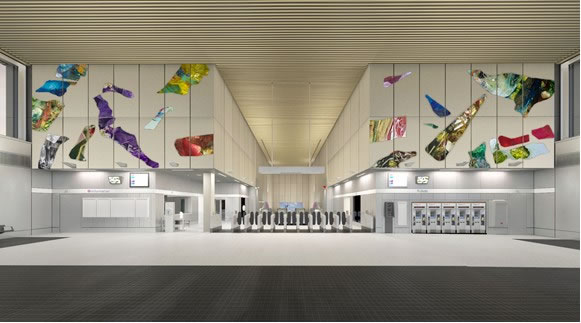Original Local Art For Northern Line Extension Stations
New ticket halls will reflect the area's heritage and worth

Picture: Samara Scott’s work will feature items scavenged from Nine Elms
November 6, 2019
Two artists from South West London have created original artwork for the two new tube stations on the Northern Line Extension. The stations will be known as Nine Elms and Battersea Power Station and will open to the public in 2021.
Fully excavated tunnels are already in place and engineering trains have been successfully test-driven throughout the new extension of the Northern Line from Kennington.
Now the focus is on creating the two new stations interiors and getting the platforms ready for public use. Alexandre da Cunha, who is originally from Brazil but now lives and works in London, is providing artwork for Battersea Power Station, while Brixton’s Samara Scott, who has exhibited Battersea Park’s Pump House Gallery, will be working at Nine Elms.

Da Cunha’s Sunset, Sunrise, Sunset (above) is inspired by the former control room at Battersea Power Station and will stretch to almost 100 metres in length. Da Cunha will be using a rotating billboard to create two friezes which will face each other along the length of the ticket hall. Vertical bars will represent the production and output of electricity provided by the Power Station in its previous era and the friezes will be made up of different strands gradually fading from one colour to another over the length of the entire image. The colours have been extracted from photos of London sunsets and sunrises.
Alexandre da Cunha said, “Although the core of this piece is colour and its reference to landscape, the work focuses on the idea of movement, cycle and repetition. The analogue aspect of the panels function as an antidote to our constant relationship with digital media, a counterpoint to screens acting as an extension of our bodies.”
At Nine Elms Station Samara Scott’s Nine Metre high artwork will be set into concrete panels in the ticket hall. Excavated sections of the concrete panels will contain objects and materials which Scott intends to scavenge from the local area. Food shops, flower markets, and items washed up on the banks of the Thames will all be used as sources as well as construction site debris, and soil and matter from the newly excavated tunnels of the Northern Line Extension.
Scott explains, “I am interested in archiving a rapidly mutating landscape; I find the Nine Elms area a surreal tapestry of high-rise 3D rendered bionic futurism, a horizon of furious construction. All these superimpositions, layers of Latin community over medieval river beds, office worker transit, squatter communities, gay subculture histories and Sunday junk markets all lapping at the tideline of the old motorway belt into the city: the Thames. I want to find a way to talk about these things simultaneously butting and bleeding into each other at the tideline, and the cultural pollution-pollination in a city through materiality.”